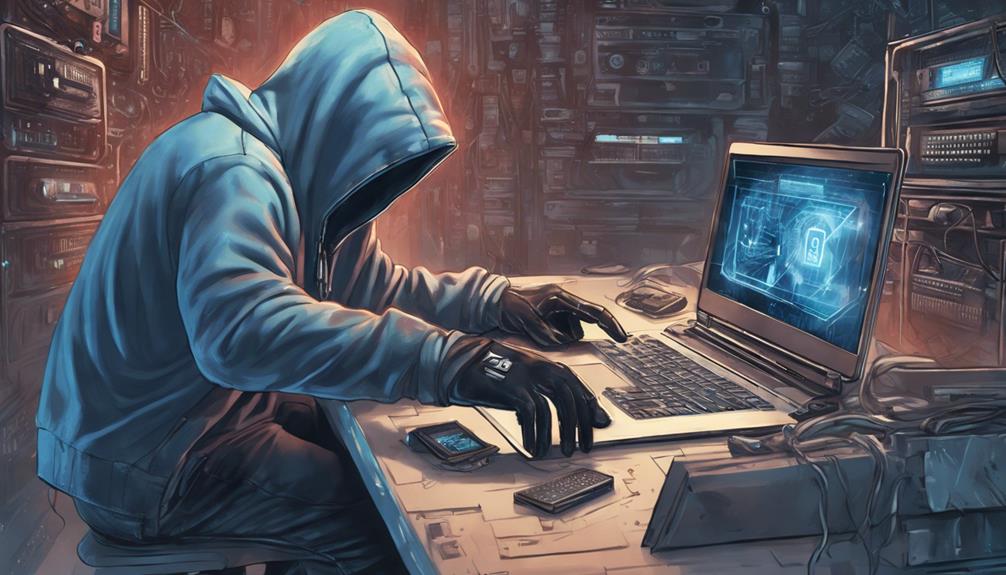Securing your savings account from hackers is paramount to protect your financial assets. Utilize strong, complex passwords and update them regularly. Implement two-step authentication for added security layers. Monitor your account diligently, setting up alerts for any suspicious activities. Report lost or stolen cards promptly to prevent unauthorized transactions. Stay informed on the latest security measures and proactive protection steps. Familiarize yourself with FDIC insurance to safeguard your funds. These practices fortify your account against cyber threats. Remember, staying vigilant is key to ensuring the safety of your savings. Further insights await for those seeking to fortify their financial defenses.
Key Takeaways
- Strong passwords and two-step authentication enhance security.
- Regularly monitor account activity for unauthorized access.
- Report lost or stolen cards promptly to prevent fraud.
- Stay informed on security measures and updates.
- Understand the benefits of FDIC insurance for protection.
Importance of Strong Passwords
Ensuring the use of strong passwords is paramount in safeguarding your savings account from unauthorized access by hackers. Your savings account holds valuable financial information, making it a prime target for cybercriminals seeking to exploit vulnerabilities.
By creating longer and more complex passwords that incorporate a mix of letters, numbers, and special characters, you greatly enhance the security of your account. Avoiding easily guessable information such as birthdays or common words further fortifies your defenses against hacking attempts. Additionally, regularly updating and changing your savings account password can help thwart potential security breaches and protect your sensitive data from falling into the wrong hands.
While strong passwords are essential, incorporating two-factor authentication adds an extra layer of security to your savings account. This additional verification step beyond your password significantly reduces the risk of unauthorized access, providing a more robust defense against potential hacking incidents.
Implementing Two-Step Authentication

Implementing two-step authentication is an essential measure in enhancing the security of your savings account against unauthorized access by hackers. This method, commonly used in online banking, adds an extra layer of protection by requiring a second verification step, such as a code sent to your phone.
By enabling two-step authentication, you greatly reduce the risk of unauthorized entry into your account, even if your password is compromised. This proactive approach not only prevents hackers from gaining access to your funds but also safeguards your financial information and transactions.
Many banking institutions offer two-step authentication to their customers as an option to strengthen information security and account protection. By taking advantage of this feature, you can enhance your account security and guarantee the protection of your hard-earned money from cyber threats and potential hackers.
Regular Account Monitoring

Regularly monitoring your savings account is vital in detecting any potential hacking attempts early on. By setting up alerts for transactions, balance changes, or logins, you can receive real-time notifications of suspicious activity.
Checking account statements and transaction history frequently is essential in spotting unauthorized withdrawals or transfers, ultimately safeguarding your funds from hackers.
Monitor Account Activity
Consistent vigilance over your savings account activity is an essential practice in safeguarding your finances from potential security threats. By regularly monitoring your account activity, you can promptly detect any unauthorized transactions, suspicious behavior, or security breaches. Setting up account alerts for balance changes, large withdrawals, or login attempts can provide you with timely notifications of any unusual activities, helping you stay vigilant against fraudulent activity.
It is vital to diligently review your account statements for any signs of irregular transactions, withdrawals, or transfers that could indicate potential security risks. Additionally, keeping an eye on your login history and the IP addresses accessing your account can help identify any unauthorized access attempts by hackers.
Stay Alert for Suspicious Activity
Maintaining vigilance in monitoring your savings account for suspicious activity is essential in safeguarding your financial security against potential hacking threats. By setting up account alerts, you can receive notifications for any unusual transactions or login activity, enabling you to detect and respond promptly to any unauthorized access attempts.
Being proactive in checking your account balance, transactions, and login history is vital in identifying any signs of suspicious behavior that may indicate hacking activities. Regularly reviewing your monthly statements and online banking activity for unfamiliar charges or transfers can help you stay alert to any potential security breaches.
If you notice any suspicious activity, it is imperative to report it promptly to your bank to prevent further unauthorized access and protect the integrity of your savings account. Remember, staying vigilant and actively monitoring your savings account can greatly reduce the risk of falling victim to hackers and safeguard the safety of your financial assets.
Reporting Lost or Stolen Cards

In the event of a lost or stolen debit card, promptly informing your bank is vital to prevent unauthorized transactions and protect your savings account. Reporting the loss or theft of your card to the bank is essential in safeguarding your funds from potential hackers seeking to exploit the situation.
The Electronic Funds Transfer Act provides a safety net by limiting your liability for unauthorized transactions on lost or stolen cards, but quick action on your part is still necessary. Contact your bank immediately upon discovering the loss or theft to freeze the card and prevent any unauthorized access to your funds.
Staying Informed on Security Measures

To guarantee the security of your savings account, it is vital to stay informed on the latest security measures. By following the advice of experts like Teresa Walsh, Donald Korinchak, and Eric Kraus, you can implement strong password management, two-factor authentication, and security update alerts.
These measures are indispensable in safeguarding your finances from potential hacking attempts and maintaining the integrity of your online banking accounts.
Security Update Alerts
Regularly monitoring security update alerts is essential for staying informed on the latest security measures to protect your savings account from potential hackers. These alerts provide vital information on evolving cybersecurity measures, helping you safeguard your funds against cyber threats. By staying informed about security updates, you can better understand the risks involved and take proactive steps to enhance the security of your savings account.
Being proactive in receiving security updates allows you to stay ahead of hackers who may target your savings account. It guarantees that you are aware of any changes or vulnerabilities that could potentially impact the safety of your funds. Utilizing security update alerts is a key strategy in maintaining the security of your savings account in the face of ever-evolving cyber threats.
Stay vigilant, stay informed, and stay protected by staying updated on security alerts.
Strong Password Management
Implementing essential password management practices is vital for maintaining the security of your savings account and protecting it from potential hacking threats. When managing your online savings account at some of the best banks for personal finance, it's important to create unique and complex passwords.
Opt for longer passwords that include a mix of letters, numbers, and special characters to enhance security measures. Additionally, consider using password managers to securely store and generate strong passwords for each of your accounts. These tools not only assist in creating robust passwords but also aid in safely managing them.
Regularly updating your passwords and refraining from reusing them across different accounts can greatly safeguard your savings from cyber threats. Staying informed about the latest security measures and educating yourself on potential risks associated with online banking are essential steps in fortifying the protection of your savings account.
Two-Factor Authentication
Utilizing two-factor authentication is a proactive measure to enhance the security of your savings account against potential hacking threats. This security feature adds an extra layer of protection by requiring a second form of verification, such as a code sent to your phone, in addition to your password.
By implementing two-factor authentication, you notably decrease the risk of unauthorized access to your savings account, even if your password is compromised. Financial institutions widely support this security measure to bolster account security and safeguard against malicious activities by hackers.
Enabling two-factor authentication demonstrates your commitment to actively safeguarding your savings from potential security breaches. This straightforward and easy-to-set-up security protocol offers peace of mind, assuring you that your savings account is better shielded from unauthorized access attempts.
Embracing two-factor authentication is a prudent step towards fortifying the security of your financial assets in an increasingly digital landscape.
Taking Proactive Protection Steps

To enhance the security of your savings account, it is important to proactively take steps to protect your online banking information. Implementing strong online banking passwords and enabling two-step authentication can greatly reduce the risk of unauthorized access to your account.
Regularly monitoring your account activity and setting up alerts for unusual transactions are essential practices to quickly identify and address any potential fraudulent activities. Promptly reporting lost or stolen debit cards or any unauthorized transactions is critical in safeguarding your savings against financial losses.
Moreover, understanding the consumer protections in place, such as FDIC insurance, provides an additional layer of security. FDIC insurance offers reimbursement for unauthorized transactions, underscoring the importance of personal responsibility in safeguarding your savings.
Choosing an online savings account with FDIC insurance not only secures your funds but also offers the potential for higher interest rates compared to traditional banks, making it a wise choice for protecting and growing your savings.
Frequently Asked Questions
What Bank Is the Most Secure From Hackers?
When considering security against hackers, financial institutions like Ally Bank, Marcus by Goldman Sachs, Chase, Wells Fargo, Capital One, Discover Bank, Navy Federal Credit Union, and Pentagon Federal Credit Union are known for robust cybersecurity measures.
Where Is the Safest Place to Keep Money From Hackers?
When considering security against hackers, the safest place to keep money is in an FDIC-insured savings account. This protection guarantees deposits up to $250,000 per depositor, shielding funds from unauthorized access and cyber threats effectively.
Can a Scammer Access My Savings Account?
Unauthorized access to savings accounts by scammers is a real threat. Vigilance is key to safeguarding your funds. Protect your account with robust security measures like strong passwords, two-factor authentication, and ongoing monitoring to prevent potential breaches.
Can Someone Take Money Out of Your Savings Account?
Unauthorized individuals cannot withdraw money from a savings account without proper access. Strong security measures like unique passwords and two-factor authentication protect funds. Promptly reporting lost debit card information is vital. FDIC insurance guarantees coverage.
Conclusion
To wrap up, safeguarding your savings account from hackers necessitates the implementation of strong passwords and two-step authentication. Regular monitoring, reporting lost or stolen cards, staying informed on security measures, and taking proactive protection steps are also crucial. By following these guidelines, you can guarantee the security and integrity of your financial assets.
Remember, prevention is key in protecting your hard-earned money from potential threats in the digital age.









